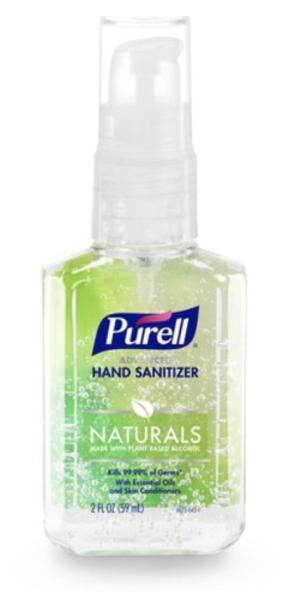
Since Covid hit, it's pretty much impossible to turn around and not be facing an alcohol-based hand sanitizer. We all use them without giving it much thought. But maybe it's time to give this topic some thought. It's winter, and that's when colds, influenza, and norovirus, aka "the stomach flu" (1), begin their annual March of Misery, at our expense, of course.
I tend to spend as little time in airport restrooms as humanly possible, but yesterday, I had no choice. It was a JFK men's room or a diaper, and I wasn't wearing a diaper – at least this time.
One thing I did notice was that many patrons avoided the sink, opting instead for the no-touch hand sanitizer on the wall instead (or frequently neither). To be fair, your average men's room participant at JFK exists somewhere on the evolutionary spectrum between Australopithecus afarensis and a New York Giants fan (Figure 1), so it is unfair to expect him to comprehend the intricacies of microbiology.

Figure 1. (Left) An Australopithecus afarensis, who somehow escaped being evolved out of existence, at JFK, is trying to figure out which gate his American Airlines flight will depart from. It's bitterly ironic that having survived 3.9 million years of never flying; he ends up on American – the festering abscess of the airline industry. (Right) A run-of-the-mill New York Giants fan is displaying typical Giants fan behavior. Photo credits: Wikimedia Commons, Twitter.
Some Science
Alcohol does a good job of killing bacteria but isn't as effective against viruses. Think about what infectious diseases people catch from each other, especially in the winter. It's viruses ahead of bacteria, and not by a little. (I have omitted Covid from the group below because its prevalence depends greatly on circulating variants – something that is impossible to predict from year to year.) The "winners" are:
- Common cold 1 billion
- Norovirus (stomach virus) 20 million annually
- Influenza (flu) 9-41 million annually
By contrast, urinary tract infections (about 15 million annually in the US) are the most common disease caused by bacteria, but if you manage to catch a UTI from some guy sitting next to you on the subway there's a news item. If you get sick from a bug "going around," a virus is most likely the culprit.
How effective are alcohol-based hand sanitizers against these three?
Common cold
There is plenty of conflicting literature about the best method to remove rhinovirus – the most common cause of colds – from hands. Here are two.
A small 2012 study in the Journal of Medical Virology concluded:
Hand washing with soap and water appeared to be much more efficient for removing rhinoviruses (1) from skin than rubbing hands with an ethanol-containing disinfectant
Savolainen-Kopra, et. al., J Med Virol. 2012 Mar;84(3):543-7. doi: 10.1002/jmv.23222.
On the other hand, a 2010 study in Antimicrobial Agents and Chemotherapy concluded just the opposite:
The ethanol hand sanitizers removed detectable virus from at least 80% of hands. All ethanol treatments were significantly more effective than no treatment, water alone, or soap and water for removal of detectable rhinovirus from the hands. Soap and water removed detectable virus from 5 (31%) of 16 hands (P = 0.04 compared to the no-treatment control). There was no difference detected among the various hand sanitizer regimens.
Turner, et. al., Antimicrobial Agents and Chemotherapy 2010; 54 (3): 1363 DOI: 10.1128/AAC.01498-09
It would appear that either method helps fight colds.
Influenza (flu)
If you ask Dr. Internet whether hand sanitizers effectively kill influenza, you'll get two answers: yes and no. It's been a rather controversial subject. However, a 2019 Japanese study found that alcohol-based sanitizers require an exposure time on the hands of 4 minutes to kill the flu virus, while soap and water did the job in 30 seconds. While it's a pretty good bet that few of us really wash our hands for a full 30 seconds, it's an even better bet that no one stands there rubbing their hands with alcohol for 4 minutes. Without going through all the literature (by then, flu season would be over), either method appears to work with the nod going to soap and water.
The "stomach flu"
If all the 20 million people who come down with the dreaded "stomach virus" every year had used an alcohol-based disinfectant on their hands, that number would be reduced to 20 million. Norovirus (1), the tough little bastard responsible for this miserable disease, is not only unaffected by alcohol but can actually make an outbreak worse by providing a false sense of prevention.
A 2011 study published in the American Journal of Infection Control concluded that facilities that had suffered norovirus outbreaks were "six times more likely to use hand sanitizers equally or more than soap and water for routine hand hygiene." Neither works very well against this highly contagious (and highly undesired) pathogen. The USDA, CDC, and OSHA recommend using a bleach solution for containing norovirus. The University of Minnesota publishes (not quite a bestseller): "Norovirus: Step-by-step Clean up of vomit and diarrhea." I'm sure it's gripping.
False sense of security?
Is it possible that the omnipresence of alcohol-based dispensers actually made the burden of winter viral illnesses worse? It makes some sense. If a cook who's just recovered from a bout of norovirus hasn't entirely cleared the virus, they could return to work, use an alcohol sanitizer on their hands, and prepare lunch for 300 students that could be the start of yet another outbreak, especially when one realizes that the fecal-oral route is one of the ways that the bug can be transmitted. Next time you're at the inlaws for dinner, and there's a lull in the conversation, keep this in mind. It can be an effective icebreaker.
NOTES:
(1) Norovirus causes vomiting and diarrhea in children and adults, while rotavirus occurs mostly in children. Highly effective vaccines are available for rotavirus but none for norovirus, despite this being a very hot research topic with several biotech companies involved.



